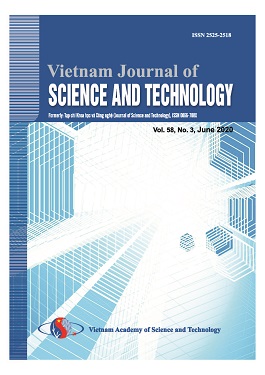Synthesis and comparative photoluminescence of CdZnSe / ZnS and CdZnSe / ZnSeS alloy quantum dots
Author affiliations
DOI:
https://doi.org/10.15625/0866-708X/52/3/3449Abstract
In order to search for new structures and compositions of quantum dots, suppress the blinking photoluminescence (random changes between high emission state ( on) and low emission status ( off ) under continuous photo- excitation ) and serve the application purposes in bio- medical and in optoelectronic devices , we have studied the fabrication of new alloy quantum dots ( QDs ). In this paper, we present new results on alloy core / shell quantum dots, with changed alloy shell composition, that was CdZnSe/ZnSexS1-x a ML with x ( x = 0 , 0.2, 0.4, 0.5 , 0.6, 0.8) and the shell thickness in monolayer (ML) ( a = 2 , 4 , 6 ) . The emission spectra and the intensity change according to the composition of the alloy shell. The full width a half maximum ( FWHM ) of the emission spectra of quantum dots CdZnSe is 25.5 nm. Covered with a shell layer, the emission intensity of the CdZnSe core increases along with the shell thickness. For comparison purpose, two different shell materials have been used, which are ZnS and ZnSeS alloy. With the same shell thickness, the emission wavelengths and intensity of the QDs change when the shell’s composition changes.The photoluminescence (PL) decay and the PL blinking of the alloy QDs was studied. It was shown that the alloy QDs spent by the nanocrystal in the ON state ranged typically between 20 and 40 %, and was dependent on the core composition. Detailed discussions on the experiment results are presented.Downloads
Downloads
Published
How to Cite
Issue
Section
License

This work is licensed under a Creative Commons Attribution-ShareAlike 4.0 International License.
Vietnam Journal of Sciences and Technology (VJST) is an open access and peer-reviewed journal. All academic publications could be made free to read and downloaded for everyone. In addition, articles are published under term of the Creative Commons Attribution-ShareAlike 4.0 International (CC BY-SA) Licence which permits use, distribution and reproduction in any medium, provided the original work is properly cited & ShareAlike terms followed.
Copyright on any research article published in VJST is retained by the respective author(s), without restrictions. Authors grant VAST Journals System a license to publish the article and identify itself as the original publisher. Upon author(s) by giving permission to VJST either via VJST journal portal or other channel to publish their research work in VJST agrees to all the terms and conditions of https://creativecommons.org/licenses/by-sa/4.0/ License and terms & condition set by VJST.
Authors have the responsibility of to secure all necessary copyright permissions for the use of 3rd-party materials in their manuscript.







 Vietnam Journal of Science and Technology (VJST) is pleased to notice:
Vietnam Journal of Science and Technology (VJST) is pleased to notice: